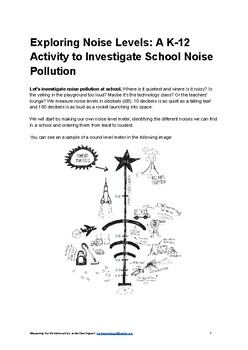Exploring Noise Levels: A K-12 Activity to Investigate School Noise Pollution
86 Downloads
Making and Live Coding
4 Followers
Grade Levels
3rd - 12th, Homeschool
Subjects
Resource Type
Standards
CCSS3.MD.A.2
CCSS3.MD.B.3
CCSS3.MD.B.4
CCSS4.MD.A.2
Formats Included
- PDF
Pages
11 pages
Making and Live Coding
4 Followers
Description
In this engaging and educational activity, students will embark on a journey to explore and understand noise pollution within their school environment. The central question of this activity is, "How noisy is a school day?" Through this exploration, students will learn about noise levels, measured in decibels (dB), and gain awareness about the varying degrees of sound in different school settings.
Objective:
The main objective is to help students comprehend the concept of noise pollution and its presence in their daily school life, encouraging them to think critically about their auditory environment.
Activity Outline:
- Creating a Noise Level Meter: Students will begin by crafting their own simple noise level meters. This hands-on project not only introduces them to the basic principles of sound measurement but also stirs creativity and engineering skills.
- Identifying School Noises: Guided by their teachers, students will identify different sources of noise within the school - from the quiet rustle of leaves to the boisterous energy of the playground. This part of the activity encourages observation and listening skills.
- Noise Discovery Walk: In small groups, students will take a walk around the school to record the noise levels in various locations such as classrooms, the playground, technology labs, the cafeteria, and the teachers' lounge. This exploration will help them understand the dynamics of sound in different environments.
- Data Collection and Analysis: Students will use their noise level meters to measure and record the decibel levels at each location. They will then analyze the data to determine the quietest and loudest areas in their school.
- Discussion and Reflection: After the data collection, there will be a group discussion where students can share their findings and insights. This is a great opportunity for them to reflect on the impact of noise pollution and discuss ways to minimize it.
- Presentation and Awareness Campaign: As a concluding activity, students can create presentations or posters summarizing their findings and proposing solutions to reduce noise pollution in their school. This encourages them to take an active role in improving their school environment.
Total Pages
11 pages
Answer Key
Does not apply
Teaching Duration
3 days
Report this resource to TPT
Reported resources will be reviewed by our team. Report this resource to let us know if this resource violates TPT’s content guidelines.
Standards
to see state-specific standards (only available in the US).
CCSS3.MD.A.2
Measure and estimate liquid volumes and masses of objects using standard units of grams (g), kilograms (kg), and liters (l). Add, subtract, multiply, or divide to solve one-step word problems involving masses or volumes that are given in the same units, e.g., by using drawings (such as a beaker with a measurement scale) to represent the problem.
CCSS3.MD.B.3
Draw a scaled picture graph and a scaled bar graph to represent a data set with several categories. Solve one- and two-step “how many more” and “how many less” problems using information presented in scaled bar graphs. For example, draw a bar graph in which each square in the bar graph might represent 5 pets.
CCSS3.MD.B.4
Generate measurement data by measuring lengths using rulers marked with halves and fourths of an inch. Show the data by making a line plot, where the horizontal scale is marked off in appropriate units-whole numbers, halves, or quarters.
CCSS4.MD.A.2
Use the four operations to solve word problems involving distances, intervals of time, liquid volumes, masses of objects, and money, including problems involving simple fractions or decimals, and problems that require expressing measurements given in a larger unit in terms of a smaller unit. Represent measurement quantities using diagrams such as number line diagrams that feature a measurement scale.





